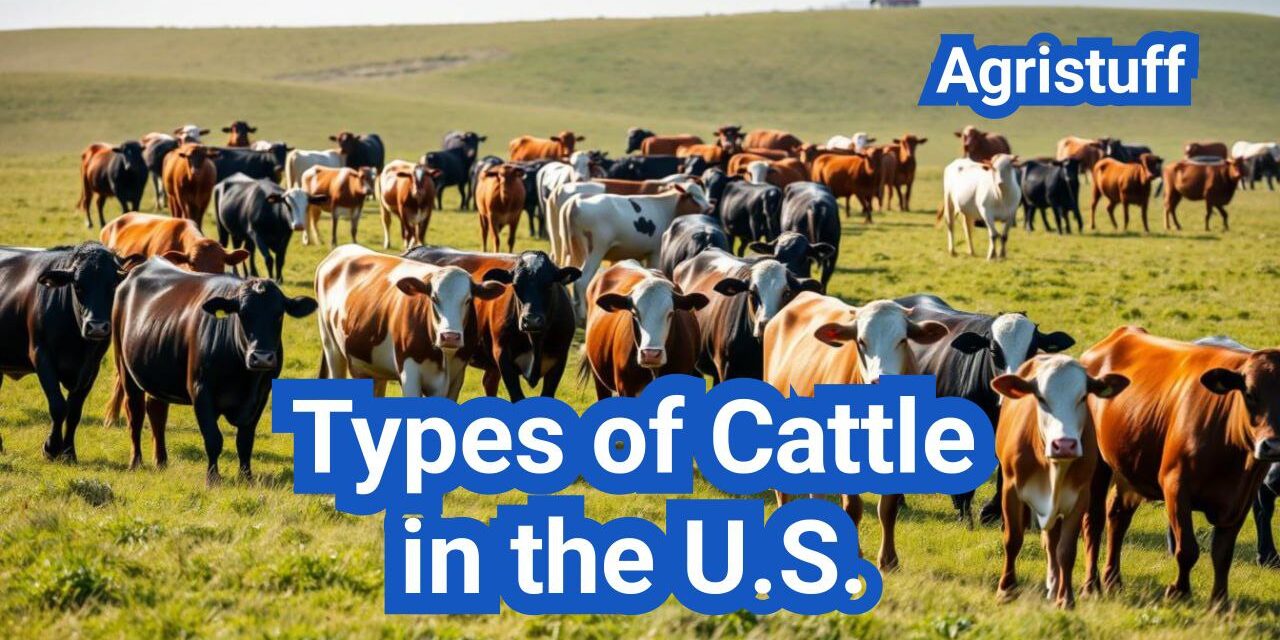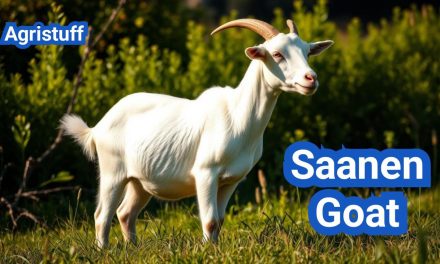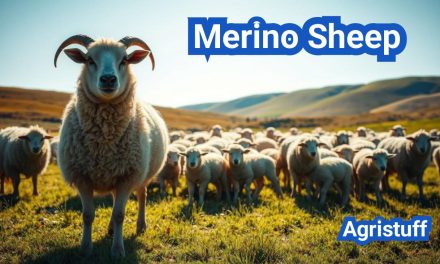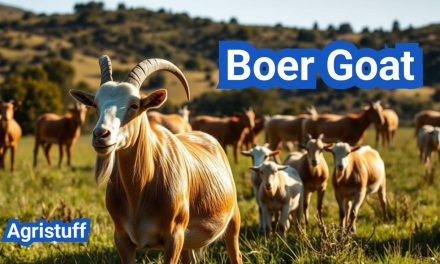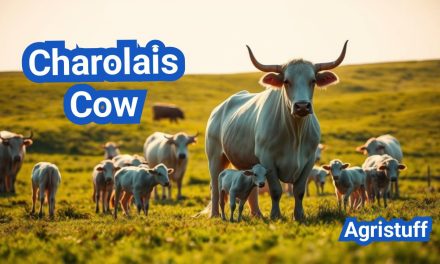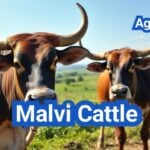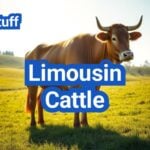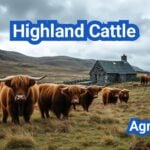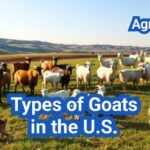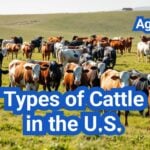The United States is home to a diverse range of cattle breeds, each with its unique characteristics and uses. Cattle production is a significant industry in the U.S., with various breeds used for beef production, dairy farming, and dual-purpose uses.
Understanding the different cattle breeds is essential for farmers, ranchers, and consumers alike. The main categories of cattle breeds include beef breeds, known for their meat production, dairy breeds, renowned for their milk production, and dual-purpose breeds, which serve both purposes.
Key Takeaways
- The U.S. cattle industry Guide includes various breeds for beef cattle, dairy cattle, and dual-purpose uses.
- Beef breeds are known for their meat production, while dairy breeds are renowned for their milk.
- Dual-purpose breeds serve both beef and dairy purposes.
- Understanding cattle breeds is crucial for farmers, ranchers, and consumers.
- The main categories of cattle breeds are beef, dairy, and dual-purpose breeds.
Understanding Cattle Classifications in the United States
The U.S. cattle industry is built on a foundation of various cattle classifications, primarily divided into Bos Taurus and Bos Indicus. Understanding these classifications is essential for producers, breeders, and consumers alike, as they influence breeding programs, production systems, and market dynamics.
Bos Taurus vs. Bos Indicus: Fundamental Differences
The primary distinction between Bos Taurus and Bos Indicus cattle lies in their evolutionary history and adaptability to different environments. Bos Taurus, commonly associated with European breeds, is generally more cold-hardy and suited to temperate climates. In contrast, Bos Indicus, originating from the Indian subcontinent, is known for its heat tolerance and is often used in tropical and subtropical regions.
Bos Indicus cattle are characterized by their distinctive hump, larger ears, and a generally more rugged appearance compared to Bos Taurus. These physical adaptations contribute to their ability to withstand high temperatures and humidity levels, making them ideal for operations in southern U.S. states.
The Historical Development of U.S. Cattle Industry
The history of the U.S. cattle industry is a story of continuous adaptation and innovation. Early cattle introductions were primarily Bos Taurus breeds from Europe, brought over by Spanish and British colonists. As the industry expanded, particularly during the 19th century, cattle breeding became more sophisticated, incorporating various breeds to enhance desirable traits such as hardiness, growth rate, and milk production.
The development of the cattle industry was also influenced by geographical expansion and technological advancements. The introduction of railroads facilitated the transportation of cattle across the country, while improvements in fencing and pasture management allowed for more controlled breeding programs.
Different Types of Cattle and Their Purposes

Different types of cattle breeds are utilized in the United States, primarily for beef, dairy, and dual-purpose production. The diverse range of cattle breeds allows farmers and ranchers to choose the most suitable type for their specific agricultural needs.
Purpose-Based Classification System
Cattle breeds are classified based on their primary purpose, which can be broadly categorized into beef, dairy, and dual-purpose types. Beef cattle are raised specifically for meat production, while dairy cattle are bred for their milk. Dual-purpose breeds serve both purposes, offering a balance between milk and meat production.
The purpose-based classification system helps farmers and ranchers select the most appropriate breed for their operation. This system is crucial for optimizing production and ensuring that the chosen breed is well-suited to the farm’s resources and market demands.
Breed Registries and Standards
Breed registries play a vital role in maintaining the integrity and standards of various cattle breeds. These organizations keep records of breed characteristics, ancestry, and performance, ensuring that breeders adhere to established standards.
Breed standards are essential for maintaining the quality and consistency of cattle breeds. They define the ideal characteristics of each breed, including factors such as size, coat color, and production traits.
| Breed Type | Primary Purpose | Notable Characteristics |
|---|---|---|
| Angus | Beef | High-quality meat, black coat |
| Holstein-Friesian | Dairy | High milk production, black and white coat |
| Shorthorn | Dual-Purpose | Versatile, red or white coat, suitable for both milk and meat |
Beef Cattle: Breeds and Characteristics
The United States is home to a diverse range of beef cattle breeds, each with unique characteristics and advantages. This diversity allows farmers and ranchers to select breeds that best suit their production goals, climate, and market demands.
Angus: America’s Premier Beef Breed
Angus cattle are renowned for their high-quality beef, characterized by its marbling, tenderness, and flavor. The breed’s popularity stems from its ability to produce consistent, high-grade beef that meets the demands of premium markets.
Key Characteristics of Angus Cattle:
- High marbling ability
- Fine-grained beef
- Adaptability to various production systems
Hereford: The Efficiency Experts
Hereford cattle are known for their hardiness, efficiency, and high-quality beef production. They are a popular choice among beef producers due to their mothering ability, growth rate, and carcass quality.
Advantages of Hereford Cattle:
- Docile temperament
- Efficient feed conversion
- High-quality beef
Charolais, Limousin, and Other Continental Breeds
Continental breeds like Charolais and Limousin have been introduced to the U.S. to improve beef production traits. Charolais are known for their rapid growth rate and lean meat production, while Limousin are prized for their muscling and lean beef.
| Breed | Growth Rate | Meat Characteristics |
|---|---|---|
| Charolais | Rapid | Lean |
| Limousin | Moderate to Rapid | Muscular, Lean |
| Angus | Moderate | Marbled, Tender |
Heat-Tolerant Beef Breeds: Brahman and Brangus
In warmer climates, heat-tolerant breeds such as Brahman and Brangus are preferred. Brahman cattle are known for their heat tolerance and resistance to insects, while Brangus combines the hardiness of Brahman with the beef production traits of Angus.
Benefits of Heat-Tolerant Breeds:
- Improved heat tolerance
- Insect resistance
- Hardiness in challenging environments
Specialized Beef Production Systems

Specialized beef production systems are the backbone of the U.S. cattle industry, ensuring a steady supply of high-quality beef. These systems are designed to optimize efficiency and productivity at various stages of cattle production.
Cow-Calf Operations
Cow-calf operations are the foundational segment of the beef production chain, focusing on breeding and raising calves until they are weaned. These operations typically involve maintaining a herd of brood cows and managing their reproductive cycles to ensure a consistent calf crop.
Key characteristics of cow-calf operations include:
- Breeding and calving management
- Nutritional management for brood cows and calves
- Health management to prevent disease
Stocker Operations
Stocker operations serve as a critical link between cow-calf operations and feedlot finishing systems. They involve the backgrounding of weaned calves, typically on pasture or in dry lot conditions, to promote growth before they are moved to feedlots.
The primary goals of stocker operations are to:
- Improve the overall health and vigor of cattle
- Enhance growth rates through optimal nutrition
- Prepare cattle for the transition to feedlot conditions
Feedlot Finishing Systems
Feedlot finishing systems are designed to bring cattle to market weight and finish, typically by feeding high-energy diets in confinement. These operations are crucial for producing the final product that meets consumer demands.
The efficiency of feedlot finishing systems depends on several factors, including:
| Factor | Description | Impact |
|---|---|---|
| Nutrition | High-energy diets | Rapid weight gain |
| Health Management | Disease prevention and treatment | Reduced morbidity and mortality |
| Environmental Management | Manure management and air quality control | Improved animal welfare and environmental sustainability |
In conclusion, the U.S. beef industry relies on a combination of cow-calf operations, stocker operations, and feedlot finishing systems to produce high-quality beef. Understanding these specialized production systems is essential for industry stakeholders and consumers alike.
Premium Beef Programs and Specialty Breeds
The U.S. beef industry is witnessing a surge in premium beef programs, driven by consumer demand for high-quality meat. This trend is leading to increased interest in specialty breeds that offer unique characteristics and superior taste profiles.
Premium beef programs are designed to cater to discerning consumers who are willing to pay a premium for exceptional beef. These programs often involve specific breeding practices, feeding regimens, and aging processes that enhance the tenderness, flavor, and overall quality of the beef.
Wagyu Crossbreeding Programs
Wagyu crossbreeding has gained popularity as a means to produce high-quality beef with enhanced marbling and tenderness. By crossing Wagyu cattle with other breeds, producers can create beef that combines the best traits of both parent breeds.
According to
“The American Wagyu Association has seen a significant increase in registrations over the past decade, reflecting the growing interest in Wagyu genetics for premium beef production.”
The benefits of Wagyu crossbreeding include improved marbling, which enhances the flavor and tenderness of the beef. This makes Wagyu-cross beef highly sought after in premium markets.
Best Cattle Breeds for Grass-Fed Beef
Grass-fed beef has become increasingly popular among consumers seeking a more natural and sustainable beef option. Certain cattle breeds are better suited for grass-fed production due to their hardiness and ability to thrive on pasture.
Breeds such as Angus and Hereford are commonly used in grass-fed systems due to their robust nature and ability to produce high-quality beef on grass.
- Angus: Known for their high-quality beef and adaptability to various production systems.
- Hereford: Recognized for their hardiness and efficiency in converting grass into high-quality beef.
Heritage Beef Breeds
Heritage beef breeds offer unique flavors and characteristics that are often sought after by specialty producers and consumers. These breeds have historical significance and are preserved for their genetic diversity and cultural heritage.
Examples of heritage breeds include Shorthorn and Red Poll, which are valued for their rich flavor profiles and historical importance.
By incorporating heritage breeds into premium beef programs, producers can offer diverse and unique products that appeal to consumers looking for something beyond conventional beef options.
Dairy Cattle: Breeds and Production Traits
With numerous breeds contributing to the dairy sector, understanding their characteristics is crucial for producers. The diversity in dairy cattle breeds allows farmers to choose animals that best fit their production goals and management systems.
Holstein-Friesian: The Volume Producers | Different Types of Cattle in the U.S.
Holstein-Friesian cows are renowned for their high milk production. They are the most common dairy breed in the United States, prized for their ability to produce large volumes of milk. Average milk production per lactation can exceed 22,000 pounds, making them ideal for large-scale dairy operations.
Jersey and Guernsey: Component Specialists | Different Types of Cattle in the U.S.
Jersey cattle and Guernsey breeds are known for their rich milk composition, particularly their high butterfat content. Jersey cows, for instance, produce milk with an average butterfat content of around 5%, making it ideal for cheese production and other dairy products where fat content is crucial.
Guernsey cows also offer high-quality milk with a rich flavor profile, suitable for a variety of dairy products. Their milk is often described as having a golden color due to its high beta-carotene content.
Brown Swiss and Ayrshire: Versatile Dairy Breeds | Different Types of Cattle in the U.S.
Brown Swiss cattle are recognized for their longevity and robust milk production. They offer a balance between milk volume and component quality, making them a versatile choice for dairy farmers.
Ayrshire cows are another versatile breed, known for their ease of milking and robust health. Their milk production is characterized by a good balance of protein and butterfat, suitable for a range of dairy products.
Modern Dairy Production Systems
Modern dairy farming encompasses a range of production systems, each with its unique characteristics and advantages. The choice of system depends on factors such as climate, available resources, market demands, and the farmer’s management capabilities.
Conventional Confinement Dairies | Different Types of Cattle in the U.S.
Conventional confinement dairies are characterized by housing cows in barns or large feedlots where they are fed a diet that is often rich in grains. This system allows for efficient milk production and is commonly used in large-scale dairy operations.
- High milk production per cow
- Efficient feeding and waste management
- Potential for reduced land use
Pasture-Based Dairy Operations | Different Types of Cattle in the U.S.
Pasture-based dairy operations focus on grazing cows on pasture, which can lead to lower production costs and potentially higher quality milk with better fatty acid profiles.
Key benefits include:
- Lower feed costs
- Improved cow welfare
- Potential for enhanced milk quality
Robotic Milking Systems and Breed Considerations
Robotic milking systems represent a significant technological advancement in dairy farming, allowing for automated milking and monitoring of cow health.
When implementing robotic milking systems, breed selection becomes crucial as some breeds are more suited to the automated milking process than others.
- Holsteins are commonly used due to their high milk production.
- Jerseys are also favored for their rich milk and adaptability.
- Crossbreeds can offer a balance between milk production and hardiness.
Milk Component Production and Breed Selection

The breed of dairy cattle is a key determinant of milk component production and overall milk quality. Dairy farmers and producers must carefully select breeds that align with their production goals and market demands.
Butterfat and Protein Optimization | Different Types of Cattle in the U.S.
Optimizing butterfat and protein content in milk is crucial for dairy producers, as these components significantly impact the quality and value of milk. Different breeds have varying capabilities when it comes to producing these components.
For instance, breeds like Jersey and Guernsey are renowned for their high butterfat content, making them ideal for producing rich, high-quality dairy products like cheese and butter.
Breed Impact on Milk Quality | Different Types of Cattle in the U.S.
The breed of dairy cattle not only affects the quantity of milk produced but also its quality. Factors such as somatic cell count, bacterial count, and the presence of certain milk proteins can vary significantly between breeds.
| Breed | Average Butterfat % | Average Protein % | Milk Yield (lbs/day) |
|---|---|---|---|
| Holstein | 3.7 | 3.0 | 70 |
| Jersey | 5.0 | 3.8 | 45 |
| Guernsey | 4.7 | 3.5 | 50 |
By understanding the characteristics of different dairy breeds, producers can make informed decisions about breed selection to optimize milk component production and quality.
Dual-Purpose Cattle Breeds Explained

In the world of cattle farming, dual-purpose breeds stand out for their ability to produce both high-quality beef and milk. These breeds offer farmers a versatile and efficient solution, combining the benefits of both dairy and beef production.
Shorthorn: America’s Versatile Heritage Breed | Different Types of Cattle in the U.S.
The Shorthorn breed is one of the oldest and most versatile dual-purpose breeds in the United States. Known for their hardiness and ease of handling, Shorthorns have been a staple in American farming for centuries. They are praised for their ability to produce high-quality beef while also providing a respectable milk yield.
A key advantage of Shorthorn cattle is their adaptability to various farming systems, from intensive grain-finishing operations to more extensive grass-based systems. This adaptability, combined with their dual-purpose nature, makes them an attractive choice for farmers looking to diversify their products.
Red Poll and Devon: Traditional Dual-Purpose Options | Different Types of Cattle in the U.S.
Red Poll and Devon are two other notable dual-purpose breeds that have been valued for their productivity and hardiness. The Red Poll is known for its rich milk and high-quality beef, while the Devon is celebrated for its lean beef and decent milk production. Both breeds are well-suited to a variety of farming conditions and are recognized for their longevity and fertility.
“The Red Poll breed is renowned for its ease of calving and rich milk production, making it an ideal choice for farmers seeking a low-maintenance, dual-purpose breed.”
Normande and Fleckvieh: European Dual-Purpose Imports | Different Types of Cattle in the U.S.
In recent years, European breeds such as the Normande and Fleckvieh have gained popularity in the U.S. for their dual-purpose capabilities. The Normande breed is appreciated for its high milk production and the quality of its beef, while the Fleckvieh is known for its robust milk production and fast-growing calves. These breeds bring a new dimension to dual-purpose farming in America, offering farmers a chance to diversify their operations with high-performing cattle.
As the agricultural landscape continues to evolve, dual-purpose cattle breeds like Shorthorn, Red Poll, Devon, Normande, and Fleckvieh are poised to play a significant role in shaping the future of cattle farming in the United States.
Cattle Breeding and Genetic Selection Tools

Cattle breeders now rely on sophisticated genetic selection tools to improve their herds. The cattle breeding industry has seen significant advancements with the introduction of technologies such as Expected Progeny Differences (EPDs) and genomic testing.
Understanding EPDs for Beef Cattle Selection
EPDs are a crucial tool in beef cattle selection, providing breeders with estimates of an animal’s genetic potential for various traits. These traits include growth rate, milk production, and carcass characteristics. By using EPDs, breeders can make informed decisions about which animals to breed, retain, or sell.
Key Benefits of EPDs:
- Improved genetic progress
- Enhanced selection accuracy
- Better decision-making
| Trait | EPD Description | Unit of Measurement |
|---|---|---|
| Birth Weight | Expected difference in birth weight | Pounds |
| Weaning Weight | Expected difference in weaning weight | Pounds |
| Milk Production | Expected difference in milk production | Pounds |
Genomic Testing and Modern Breeding | Different Types of Cattle in the U.S.
Genomic testing has revolutionized cattle breeding by providing detailed information about an animal’s genetic makeup. This technology allows breeders to identify genetic markers associated with desirable traits, enabling more precise selection.
Genomic testing involves analyzing an animal’s DNA to predict its genetic potential. This information can be used to complement traditional selection methods, such as EPDs, to improve the overall quality of the herd.
Crossbreeding Strategies for Commercial Operations | Different Types of Cattle in the U.S.
Crossbreeding is a common practice in commercial cattle operations, aimed at exploiting hybrid vigor to improve productivity. By crossing breeds with complementary strengths, producers can create animals that are better suited to their specific production environment.
Benefits of Crossbreeding:
- Increased heterosis (hybrid vigor)
- Improved adaptability
- Enhanced productivity
By combining the right breeds and utilizing genetic selection tools, cattle producers can significantly enhance the efficiency and profitability of their operations.
Regional Adaptations: Selecting Cattle for Different U.S. Climates

Regional adaptations play a crucial role in determining the suitability of cattle breeds for different U.S. climates. The diverse geography and climate across the United States necessitate careful selection of cattle breeds that can thrive in specific regional conditions.
The climate varies significantly from one region to another, ranging from the hot and humid conditions in the southern states to the cold and snowy winters in the northern regions, and the dry conditions in the western rangelands. Each of these climates requires cattle breeds with specific adaptations to survive and be productive.
Heat-Tolerant Breeds for Southern States | Different Types of Cattle in the U.S.
In the southern United States, heat-tolerant breeds are essential for cattle operations. Breeds such as Brahman and Brangus are well-suited to the hot and humid climate. These breeds have a thick coat that reflects sunlight and helps to dissipate heat, making them ideal for regions with high temperatures.
Cold-Hardy Breeds for Northern Regions | Different Types of Cattle in the U.S.
In contrast, the northern regions require cattle breeds that can withstand cold temperatures and snowy conditions. Breeds like Angus and Hereford are known for their hardiness and ability to thrive in colder climates. Their thick coats provide insulation against the cold, ensuring their survival and productivity.
Drought-Resistant Cattle for Western Rangelands | Different Types of Cattle in the U.S.
The western United States is characterized by dry and arid conditions, necessitating cattle breeds that are drought-resistant. Breeds such as Beefmaster and Santa Gertrudis have been developed to thrive in these conditions. They have a robust constitution and can survive with minimal water intake, making them suitable for the western rangelands.
| Region | Climate Condition | Suitable Breeds |
|---|---|---|
| Southern States | Hot and Humid | Brahman, Brangus |
| Northern Regions | Cold and Snowy | Angus, Hereford |
| Western Rangelands | Dry and Arid | Beefmaster, Santa Gertrudis |
Different Types of Cattle Farming and Management

Effective cattle farming requires a comprehensive understanding of nutritional needs, feeding systems, and infrastructure. Cattle farming management is crucial for the success of any cattle operation, whether it’s a small farm or a large ranch.
Nutritional Requirements Across Breed Types
Cattle have different nutritional requirements based on their breed, age, and production stage. For instance, beef cattle require more energy and protein during the finishing stage to achieve optimal marbling and weight gain. In contrast, dairy cattle need a diet rich in fiber and nutrients to support milk production.
The nutritional needs of cattle can be met through various feeding strategies, including grazing, hay, silage, and concentrates. Understanding the nutritional requirements of different cattle breeds is essential for optimizing their performance and health.
| Cattle Type | Nutritional Requirements | Feeding Strategies |
|---|---|---|
| Beef Cattle | High energy and protein | Grazing, concentrates |
| Dairy Cattle | High fiber and nutrients | Hay, silage, concentrates |
| Dual-Purpose Cattle | Balanced energy and nutrients | Grazing, hay, concentrates |
Different Types of Cattle Feed and Feeding Systems
Cattle feed can vary significantly depending on the type of cattle, their production stage, and the farming system. Common types of cattle feed include grazing, hay, silage, and concentrates. Each type of feed has its advantages and is suited to different cattle breeds and production systems.
Feeding systems can range from simple grazing to complex total mixed ration (TMR) systems. The choice of feeding system depends on factors such as climate, available resources, and the farmer’s management capabilities.
Different Types of Cattle Fencing and Handling Facilities
Cattle fencing is a critical component of cattle farming, serving to contain the animals, protect them from predators, and manage grazing. Different types of fencing include barbed wire, high-tensile wire, and electric fencing. The choice of fencing depends on the terrain, cattle type, and management practices.
Handling facilities are also essential for cattle farming, enabling farmers to manage their cattle safely and efficiently. Well-designed handling facilities can reduce stress on both the animals and the handlers, improving overall farm productivity.
By understanding the different aspects of cattle farming and management, farmers can make informed decisions to optimize their operations and improve animal welfare.
Regulatory Framework for U.S. Cattle Operations

Understanding the regulatory framework is essential for cattle producers to ensure compliance with USDA regulations and maintain operational efficiency. The U.S. cattle industry is subject to a complex set of regulations that govern various aspects of cattle production, including biosecurity, animal welfare, and environmental impact.
USDA Regulations by Production Type | Different Types of Cattle in the U.S.
The USDA regulates cattle operations based on their production type, which includes beef, dairy, and dual-purpose breeds. Each production type has specific guidelines that producers must follow.
- Beef Cattle: Regulations focus on breeding, feeding, and finishing practices.
- Dairy Cattle: Emphasis is on milk production standards, milking practices, and cow health.
- Dual-Purpose Cattle: Regulations cover both beef and dairy aspects.
Key USDA Regulations:
- Identification and tracking of cattle
- Feeding practices, including feedlot operations
- Health standards and disease control measures
Cattle Biosecurity Checklist | Different Types of Cattle in the U.S.
Biosecurity is critical in preventing disease outbreaks in cattle operations. A comprehensive biosecurity checklist includes:
- Access Control: Limiting access to the farm and cattle areas.
- Sanitation: Regular cleaning and disinfection of equipment and facilities.
- Monitoring: Regular health checks for cattle.
- Vaccination Programs: Implementing vaccination programs as recommended by veterinarians.
Animal Welfare Standards by Breed and Type | Different Types of Cattle in the U.S.
Animal welfare standards vary by breed and type of cattle, with considerations for their specific needs and handling practices.
- Handling Practices: Gentle handling to minimize stress.
- Space and Housing: Adequate space and appropriate housing conditions.
- Health Care: Regular veterinary care and monitoring.
Producers must adhere to these standards to ensure the well-being of their cattle and compliance with regulatory requirements.
Choosing the Right Cattle Type for Your Operation
Selecting the ideal cattle breed is crucial for the success of a cattle operation. With various breeds available, each with unique characteristics, choosing cattle that align with your operation’s goals and environment is essential.
The type of cattle you choose will significantly impact your operation’s productivity and profitability. Whether you’re focusing on beef, dairy, or dual-purpose breeds, understanding the strengths and weaknesses of different cattle breeds is vital for making informed decisions.
When considering cattle breed selection, factors such as climate, feed availability, and market demand should be taken into account. By choosing the right cattle type for your operation, you can optimize production, reduce costs, and improve overall efficiency.
Ultimately, the right cattle breed can make a significant difference in the success of your operation. By carefully evaluating your needs and selecting breeds that fit your specific conditions, you can achieve your production goals and maintain a sustainable and profitable cattle operation.
FAQ
What are the main categories of cattle breeds in the U.S.?
The main categories of cattle breeds in the U.S. are beef, dairy, and dual-purpose breeds.
What is the difference between Bos Taurus and Bos Indicus cattle?
Bos Taurus cattle are of European origin and are generally more cold-hardy, while Bos Indicus cattle are of Indian origin and are more heat-tolerant.
What is the purpose-based classification system for cattle breeds?
The purpose-based classification system categorizes cattle breeds based on their intended use, such as beef, dairy, or dual-purpose.
What are some popular beef cattle breeds in the U.S.?
Some popular beef cattle breeds in the U.S. include Angus, Hereford, and Charolais.
What are the different types of beef production systems?
The different types of beef production systems include cow-calf operations, stocker operations, and feedlot finishing systems.
What are premium beef programs and specialty breeds?
Premium beef programs and specialty breeds include Wagyu crossbreeding and heritage breeds, which are known for their high-quality beef.
What are some popular dairy cattle breeds in the U.S.?
Some popular dairy cattle breeds in the U.S. include Holstein-Friesian, Jersey, and Brown Swiss.
What are the different types of dairy production systems?
The different types of dairy production systems include conventional confinement dairies and pasture-based operations.
How does breed selection impact milk component production?
Breed selection can impact milk component production, including butterfat and protein optimization.
What are dual-purpose cattle breeds?
Dual-purpose cattle breeds, such as Shorthorn and Red Poll, are used for both beef and dairy production.
What tools are used in cattle breeding and genetic selection?
Tools used in cattle breeding and genetic selection include EPDs and genomic testing.
Why is regional adaptation important in cattle selection?
Regional adaptation is important in cattle selection because different breeds are better suited to different climates and regions.
What are the nutritional requirements for different cattle breeds?
Nutritional requirements vary across breed types, and it’s essential to understand these requirements to ensure optimal cattle health.
What are the different types of cattle feed and feeding systems?
The different types of cattle feed and feeding systems include various feed types and feeding strategies.
What are the regulatory frameworks for U.S. cattle operations?
The regulatory frameworks for U.S. cattle operations include USDA regulations and animal welfare standards.
How do I choose the right cattle breed for my operation?
Choosing the right cattle breed for your operation depends on several factors, including your climate, production goals, and management practices.
Conclusion of: Different Types of Cattle In USA
If you are researching different types of cattle in the U.S., it helps to start with the big picture: beef breeds, dairy breeds, and dual-purpose genetics that deliver both milk and meat. Across regions and production systems, different types of cattle excel for carcass quality, feed efficiency, milk components, climate tolerance, and docility. Understanding how breed traits match your land, markets, and management will save time and money over the long term. To ground your plan in U.S. realities, we’ll use data-driven sources and practical guidance at every step. USDA ERS: Cattle & Beef Sector Overview
How the industry categorizes different types of cattle
At the highest level, different types of cattle fall into beef, dairy, and dual-purpose classes. Beef breeds are selected for growth, muscling, marbling, and efficiency in finishing systems, while dairy breeds emphasize lactation traits like milk yield, butterfat, protein, udder health, and fertility. Dual-purpose breeds balance both. Within each class, you’ll see British, Continental, and indicine (Bos indicus) influences, plus composites that blend strengths. These categories help producers match genetics to forage base, climate, and marketing goals in the U.S. Oklahoma State University: Breeds of Livestock
Beef breeds overview: strengths and use cases | Different Types of Cattle in the U.S.
For different types of cattle aimed at beef, British breeds (e.g., Angus, Hereford, Shorthorn) often deliver marbling and maternal traits, while Continental breeds (e.g., Charolais, Limousin, Simmental, Gelbvieh) contribute growth and muscling. Choosing among different types of cattle also depends on finishing strategy: pasture-finishing emphasizes forage conversion and moderate frames; feedlot finishing rewards ADG and carcass merit. Producers commonly crossbreed to capture heterosis in fertility, longevity, and calf vigor—key drivers of profit. Beef Improvement Federation (EPDs & selection)
Angus: the U.S. marbling benchmark | Different Types of Cattle in the U.S.
Among different types of cattle, Black Angus dominates many U.S. seedstock and commercial herds for marbling, maternal ability, and market recognition (e.g., branded beef programs). Consistent carcass traits, polled genetics, and extensive EPD data make Angus a reliable base for crossbreeding or straightbred herds. In cool to moderate climates with access to quality forage, Angus genetics often deliver competitive weaning weights and premiums on grid-based marketing systems. American Angus Association
Hereford & Shorthorn: maternal and moderate | Different Types of Cattle in the U.S.
When comparing different types of cattle for docility, maternal function, and adaptability, Hereford and Shorthorn remain stalwarts. Herefords are known for foraging ability and hardy performance, while Shorthorns offer maternal quality and, in some lines, dual-purpose potential. Both integrate well in British-influenced crossbreeding programs to hit balance points between growth, fertility, and maintenance costs on grass. American Hereford Association
Continental muscle: Charolais, Limousin, Simmental, Gelbvieh
For producers evaluating different types of cattle to add muscling and gain, Continental breeds are proven tools. Charolais calves grow fast and yield heavy carcasses; Limousin leans toward muscular, high-yield frames; Simmental brings maternal and growth; Gelbvieh adds fertility and calf performance. Used as terminal sires or in structured crosses, these breeds help optimize carcass weight and retail yield without sacrificing too much marbling when paired with British dams. American-International Charolais Association
Wagyu: marbling and premium niches | Different Types of Cattle in the U.S.
Within different types of cattle, Wagyu is synonymous with extreme marbling potential and premium beef niches. U.S. producers use fullblood, purebred, or F1 Wagyu x Angus crosses to improve intramuscular fat and eating quality. Management emphasizes longer feeding periods, carefully formulated rations, and meticulous health programs to protect high-value carcasses. As with any niche, success depends on market access and cost control. American Wagyu Association
Heritage & landrace: Texas Longhorn and Florida Cracker
Some different types of cattle serve conservation, low-input grazing, or agritourism goals. Texas Longhorns are renowned for hardiness, calving ease, and forage efficiency; Florida Cracker cattle represent a rare heritage population adapted to heat and humidity. These breeds can add “story value” and resilience in extensive systems, though they’re typically not maximized for high-input feedlot performance. Texas Longhorn Breeders Association of America
Niche grass & cold-climate fits: Highland and Belted Galloway
For cold regions and grass-based marketing, different types of cattle like Highland and Belted Galloway (“Belties”) offer thick coats, foraging efficiency, and distinctive appearance that can differentiate direct-to-consumer brands. Moderate mature size can align with limited winter feed, and carcass quality can be competitive when genetics and grazing are managed well. American Highland Cattle Association
Dairy breeds overview: milk, components, and efficiency
In dairy systems, different types of cattle are evaluated on milk production, butterfat, protein, fertility, health, and feed efficiency. Housing (freestall or pasture-based), milking systems (parlor or AMS robots), and ration design drive output. U.S. herds often blend breed advantages—e.g., Jerseys for components and Holsteins for volume—seeking the best net milk price under regional processors and premiums. USDA ERS: Dairy Sector Overview
Holstein: volume leader in the U.S. | Different Types of Cattle in the U.S.
When scanning different types of cattle in dairy, Holsteins deliver the highest average milk volume per cow, supported by decades of genetic improvement and on-farm data. Strong yields, mature frames, and a vast AI sire catalog make optimization straightforward. Management focuses on cow comfort, lameness prevention, and reproductive efficiency to capture the breed’s production potential sustainably. Holstein Association USA
Jersey & Guernsey: components and feed efficiency | Different Types of Cattle in the U.S.
For producers comparing different types of cattle, Jerseys are prized for butterfat and protein, smaller body size, and strong feed efficiency—often translating to favorable income-over-feed-cost. Guernseys also command attention for golden milk color and component profiles in specialty markets. These breeds can shine where processors reward butterfat and protein. American Jersey Cattle Association
Brown Swiss, Ayrshire, Milking Shorthorn: balanced performance
Among different types of cattle for balanced dairy performance, Brown Swiss are known for durability, calm temperament, and solid components; Ayrshires bring grazability and udder health; Milking Shorthorns offer versatility. Such breeds can diversify herd risk and fit pasture-forward dairies. The key is aligning genetics with facility design and forage resources. Brown Swiss Cattle Breeders’ Association
Dual-purpose and crossbreeding options (e.g., Fleckvieh)
Producers exploring different types of cattle that balance milk and beef often consider dual-purpose lines (e.g., Fleckvieh or dual-purpose Simmental). Crosses onto Holsteins may improve fertility, health, and calf value without sacrificing too much milk. Data-driven selection using health, fertility, and component indices helps quantify tradeoffs. American Gelbvieh Association (crossbreeding & maternal traits)
Bos indicus influence and heat-tolerant composites | Different Types of Cattle in the U.S.
In southern states, different types of cattle influenced by Bos indicus (e.g., Brahman) or indicus-based composites (e.g., Brangus, Beefmaster) bring heat tolerance, parasite resistance, and longevity. Strategic use of indicine genetics can stabilize performance under heat stress while maintaining acceptable carcass traits through careful crossbreeding with British/Continental lines. OSU: Bos indicus Cattle (overview)
Matching breed to production system and forage base
Choosing among different types of cattle should flow from your forage base (cool-season vs warm-season pastures), winter feed resources, water availability, and infrastructure. Grass-finished programs reward moderate frames and forage conversion, while feedlot systems prioritize ADG and carcass merit. Partial confinement dairies may value components and feet/leg soundness for longevity in freestalls. University of Nebraska–Lincoln Beef
Climate and regional considerations across the U.S. | Different Types of Cattle in the U.S.
Your shortlist of different types of cattle should reflect local climate risks: heat stress in the Southeast, cold stress and wind in the Northern Plains, and variable precipitation in the West. Breed choices and coat characteristics, plus shade, ventilation, and water access, all affect performance. Heat-tolerant composites may reduce losses in hot zones, while thick-coated breeds fit northern winters. USDA Climate Hubs
Carcass merit, EPDs, and genomic tools | Different Types of Cattle in the U.S.
No matter which different types of cattle you favor, use EPDs and genomics to target marbling, ribeye area, feed efficiency, calving ease, fertility, and longevity. Data from breed associations and the Beef Improvement Federation standardizes comparisons, making selection more objective and repeatable across herds and environments. Beef Improvement Federation: EPD Basics
Dairy performance metrics and milk pricing reality
For dairy-leaning different types of cattle, evaluate milk volume alongside component tests, SCC, reproduction, and health events. Local processors determine mailbox price with premiums/penalties for components and quality, so breed selection should reflect the check stub, not just parlor numbers. Crossbreeding can balance traits for net returns. USDA ERS: Dairy Economics
Health, biosecurity, and welfare across breeds | Different Types of Cattle in the U.S.
Whichever different types of cattle you run, consistent vaccination, parasite control, low-stress handling, and biosecurity protect performance and public trust. Sound footing, shade, and clean water reduce lameness and heat stress. Work with veterinarians to tailor protocols for regional disease pressures and marketing timelines. USDA APHIS: Animal Health
Regulations, ID, and interstate movement
Different different types of cattle may face distinct interstate and program requirements. Official ID, health certificates, and disease control programs (e.g., brucellosis, tuberculosis) vary by destination. Always check current rules with state vets and APHIS before shipping breeding stock or show cattle. Compliance protects herds and markets. APHIS: Cattle Disease Information
Marketing channels and price discovery
As you weigh different types of cattle, consider how you’ll sell: local freezer beef, video auctions, salebarns, direct-to-packer, or dairy contracts. Grid pricing rewards carcass quality; commodity channels require uniform loads; niche sales need storytelling and consistency. Align breed choices and management with the channel that pays you best. USDA ERS: Cattle & Beef Market Outlook
Breed directories and trusted associations
To refine a shortlist of different types of cattle, browse official breed associations and land-grant resources for EPDs, benchmarks, and management guides. This keeps decisions rooted in verified data instead of hearsay. Look for transparent genetic evaluations and extension-reviewed practices. Penn State Extension: Beef Cattle
Final thought
The smartest way to select among different types of cattle is to start with your forage, climate, facilities, labor, and market, then use breed EPDs and extension guidance to hit profit targets. Whether you’re building a beef herd or a dairy string (or both through crossbreeding), choose genetics that match your system—not the other way around—and verify decisions with data each season. UNL BeefWatch (peer-reviewed extension articles)
Sources & References
- USDA ERS: Cattle & Beef Sector Overview
- USDA ERS: Dairy Sector Overview
- USDA APHIS: Animal Health
- Oklahoma State University: Breeds of Livestock
- Beef Improvement Federation
- University of Nebraska–Lincoln Beef
- American Hereford Association
- American-International Charolais Association
- North American Limousin Foundation
- American Simmental Association
- American Gelbvieh Association
- American Wagyu Association
- Texas Longhorn Breeders Association
- American Highland Cattle Association
- The U.S. Belted Galloway Society
- Holstein Association USA
- American Jersey Cattle Association
- Brown Swiss Cattle Breeders’ Association
- USDA Climate Hubs

